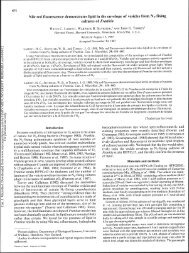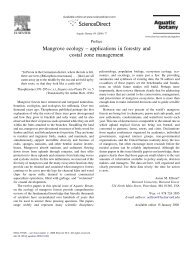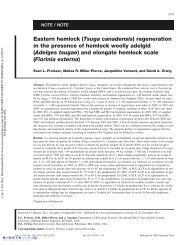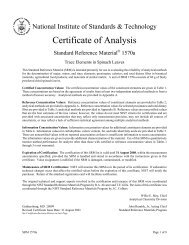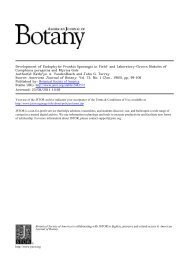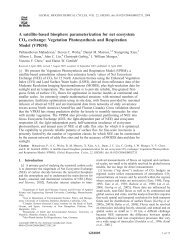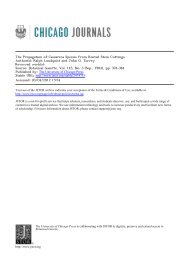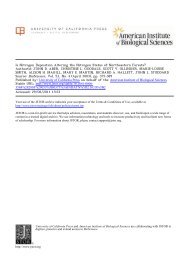Abstracts of Papers - Harvard Forest - Harvard University
Abstracts of Papers - Harvard Forest - Harvard University
Abstracts of Papers - Harvard Forest - Harvard University
You also want an ePaper? Increase the reach of your titles
YUMPU automatically turns print PDFs into web optimized ePapers that Google loves.
characteristic pr<strong>of</strong>ile, or identifying fingerprint.<br />
The composition <strong>of</strong> the pr<strong>of</strong>ile differed<br />
quantitatively and qualitatively among taxa. Taxa<br />
with few triterpenes, tentatively interpreted as<br />
primitive, occurred in dwarf forms, whereas<br />
Madagascan taxa tended to possess high numbers <strong>of</strong><br />
triterpenes reflective <strong>of</strong> specialization. This<br />
study supports the interpretation that laticifer<br />
starch grain morphology and triterpene composition,<br />
both gene mediated stable markers, can be employed<br />
to determine and correlate phylogenetic<br />
relationships between taxa <strong>of</strong> this complex genus.<br />
MAKSYMOWYCH, ROMAN* Department <strong>of</strong> Biology<br />
Villanova <strong>University</strong>, Villanova, PA 19085<br />
MYRON C. LEDBETTER, Biology Department,<br />
Brookhaven National Laboratory, Upton,<br />
NY 11973.<br />
- Fine Structure <strong>of</strong> Secretory Canals<br />
in Xanthium pennsylvanicum Petioles.<br />
Secretory canals, lined with an epithelium,<br />
occur in many families, e.g. Umbelliferae,<br />
Compositae. These canals extend continu-<br />
ously through the root and shoot systems and<br />
are known, in some cases, to secrete resins,<br />
essential oils, etc. In Xanthium the canals<br />
initials. Subsequent divisions lead to a<br />
ring <strong>of</strong> 7-12 epithelial cells surrounding a<br />
central cavity. During maturation the<br />
epithelium becomes crushed and obliterated.<br />
Canals were examined in petioles <strong>of</strong> Xanthium<br />
pennsylvanicum (Cocklebur) plants grown<br />
under long day illumination to maintain<br />
vegetative growth. The fine structure <strong>of</strong><br />
the canal and its epithelium was studied by<br />
electron microscopy <strong>of</strong> thin sections cut<br />
transverse to the principal axis <strong>of</strong> petioles<br />
from leaves in an early stage <strong>of</strong> develop-<br />
ment. The canal proper is delimited by<br />
walls <strong>of</strong> epithelial cells which protrude<br />
into a scallop shaped cavity. In comparison<br />
to the surrounding parenchyma, the epith-<br />
elial cells are smaller, cytoplasmically<br />
more dense, and less vacuolate. The epith-<br />
elium contains pleomorphic starch-free<br />
plastids with planar thylakoids frequently<br />
stacked into granna; thus, the plastids are<br />
presumed photosynthetically active.<br />
Mitochondria are abundant and <strong>of</strong>ten dense.<br />
The cytoplasm is rich in free polysomes, and<br />
smooth endoplasmic reticulum predominates<br />
LELAND C. MARSH AND JAMES L. SEAGO, JR.*. Department<br />
<strong>of</strong> Biology, State <strong>University</strong> <strong>of</strong> New York,<br />
Oswego, NY 13126.<br />
-Adventitious rooting in Typha glauca under experimental<br />
conditions.<br />
Overwintering sterile plants from a single clone <strong>of</strong><br />
T. glauca were grown in nutrient solution with last<br />
year's sterile stalk either submerged or emerged to<br />
determine the effect on adventitious rooting. The<br />
following results were observed: 1) Plants with<br />
sterile stalks above the solution showed earliest<br />
rooting (within 4 days). These plants produced<br />
35-60 lateral roots per cm over the basal 10 cm <strong>of</strong><br />
the adventitious roots. 2) Plants with submerged<br />
sterile stalks delayed rooting until 10 days, and<br />
then only after new stalks with developed aerenchyma<br />
had elongated 30 cm above the water surface. These<br />
plants had fewer adventitious roots with less lateral<br />
roots, except in the basal 1 cm. It was concluded<br />
Developmental and Structural Section 25<br />
that root development is related to the presence <strong>of</strong><br />
an air pathway from above the water surface to the<br />
rooting zone at the base <strong>of</strong> the developing buds.<br />
MAUSETH, JAMES D. Dept. <strong>of</strong> Botany, <strong>University</strong> <strong>of</strong><br />
Texas, Austin, TX 78712.-Development and anatom<br />
<strong>of</strong> the parasite Tristerix aphyllus (Loranthaceae)<br />
infecting Trichocereus chilensis (Cactaceae).<br />
Many <strong>of</strong> the large columnar cacti Trichocereus<br />
chilensis near Santiago are infected by Tristerix<br />
(= Phrygilanthus) aphyllus. This is one <strong>of</strong> the most<br />
highly reduced plants known: it is an endoparasite,<br />
the flowers being the only parts <strong>of</strong> the plant ever to<br />
emerge from the host, all the rest existing as an<br />
endophytic haustorial system; roots, stems and leaves<br />
are not produced. After infection, the parasite<br />
spreads in all directions through the thick cortex <strong>of</strong><br />
the host, eventually reaching the vascular cambium<br />
and conducting tissues. The parasite in this<br />
invasive stage occurs as a "mycelium" <strong>of</strong> uniseriate<br />
filaments that grow between host cells, deforming<br />
them, but only rarely entering them. Later growth is<br />
by apparently random cell division that produces<br />
irregular parenchymatous strands. Ultimately xylem<br />
and phloem are produced in these strands; the phloem<br />
is normal but the xylem is almost pure parenchyma,<br />
with only occasional idioblastic tracheary elements.<br />
Strands close to the epidermis <strong>of</strong> the host are able<br />
to produce adventitious flower buds that emerge<br />
through either s<strong>of</strong>t regions in the epidermis (the<br />
areoles) or through accidental breaks in it. The<br />
flower stalk may persist, forming a small perennial<br />
inflorescence that has normal wood, phloem and bark<br />
but is without leaves or chlorophyll. The portions <strong>of</strong><br />
the endophyte that produce these exophytic inflorescences<br />
do not develop normal anatomy, but persist<br />
as irregular parenchymatous strands with small amounts<br />
<strong>of</strong> xylem and phloem. Host cells appear healthy and<br />
normal, with no sign <strong>of</strong> damage caused by the presence<br />
<strong>of</strong> the parasite.<br />
MAZE, JACK. Department <strong>of</strong> Botany, <strong>University</strong><br />
<strong>of</strong> British Columbia, Vancouver, B. C. V6T 2B1,<br />
Canada. - Explanations for leaf development.<br />
The explanations <strong>of</strong>fered for leaf development are<br />
usually causal. The most common one is that leaf<br />
development is the result <strong>of</strong> ontogenetic events<br />
that are under genetic control, the cause in this<br />
case being genetic. As well, kinetics, surface<br />
area thermodynamics, and natural laws pertaining<br />
to increasing disorder have been implicated in<br />
ontogeny and may be presented as explanations <strong>of</strong><br />
leaf development. It is also possible to apply<br />
teleological explanations to leaf development since<br />
the most general form <strong>of</strong> a functional explanation<br />
for leaf development is the same as the most general<br />
form for the explanation for a vertebrate predator's<br />
hunting behaviour, an undoubted teleological system.<br />
It would thus appear that both teleological and<br />
causal explanations may be applied to leaf<br />
development. Of the causal explanations proposed,<br />
all would seem to be based in natural laws.<br />
However, causal explanations involving genetic<br />
control <strong>of</strong> ontogeny, using natural laws pertaining<br />
to chemical bonds, would not allow one to deduce<br />
increasing complexity with development. To do so,<br />
one must use natural laws pertaining to kinetics,<br />
thermodynamics or increasing disorder.




